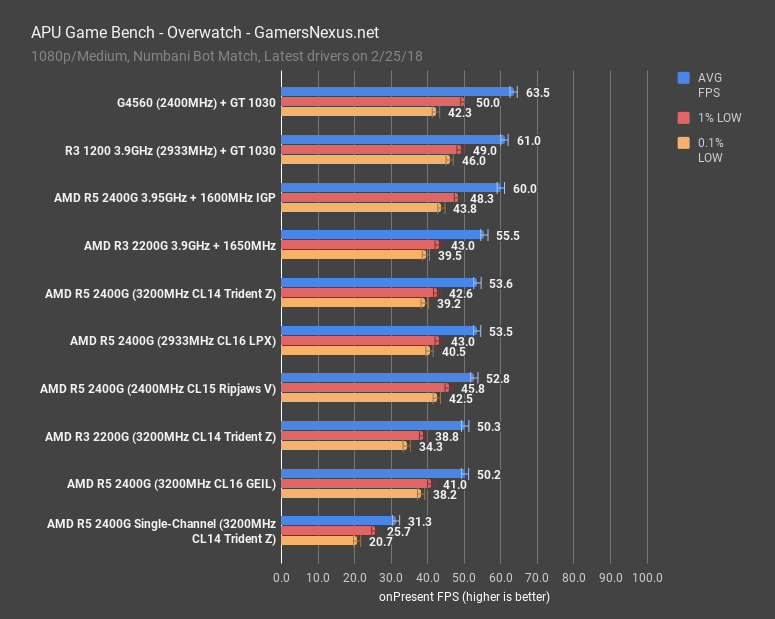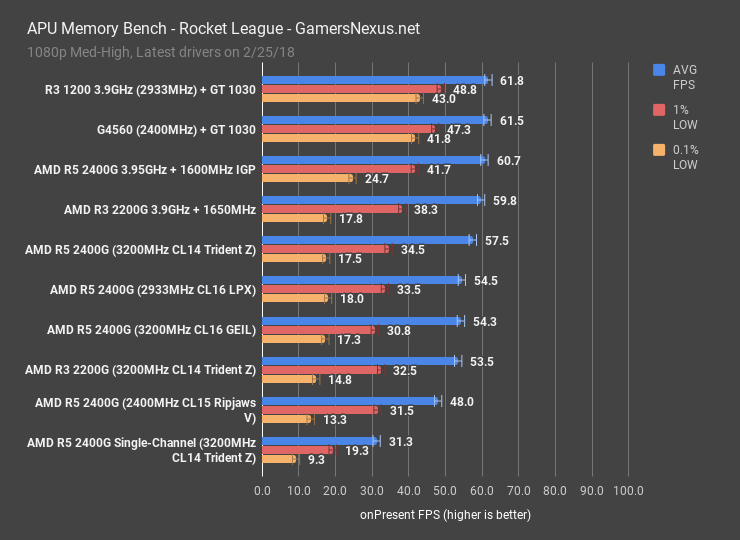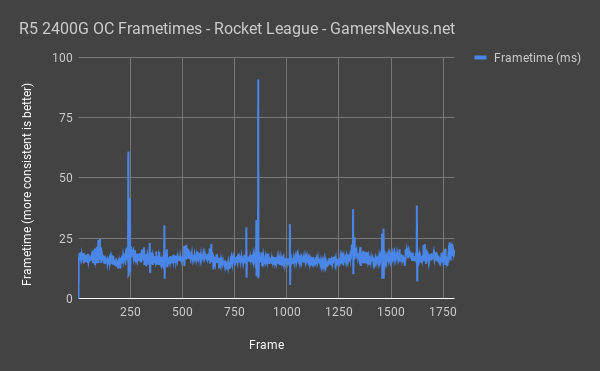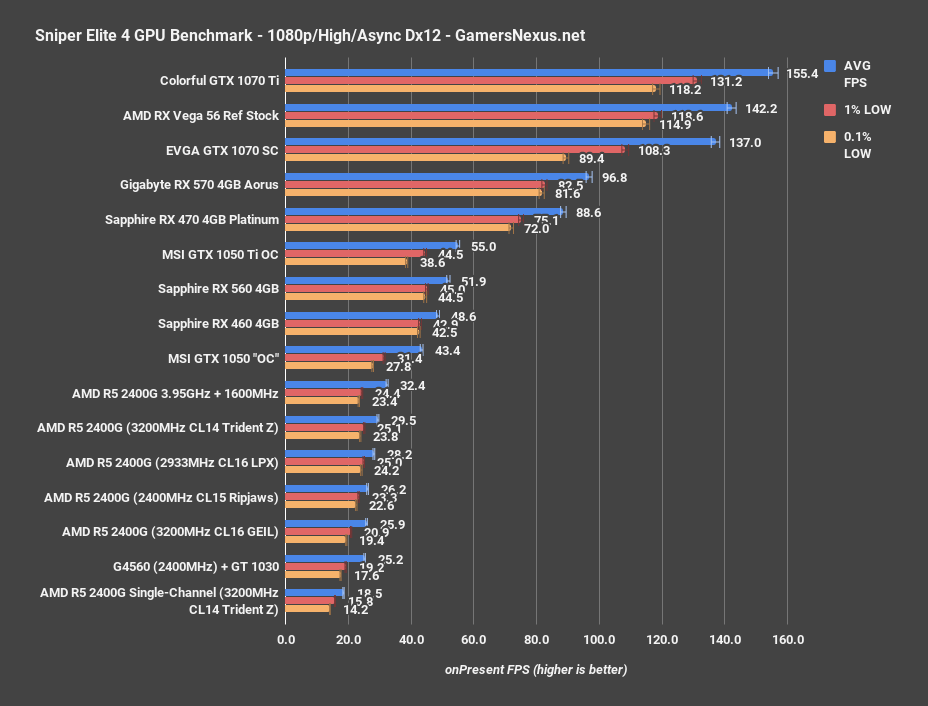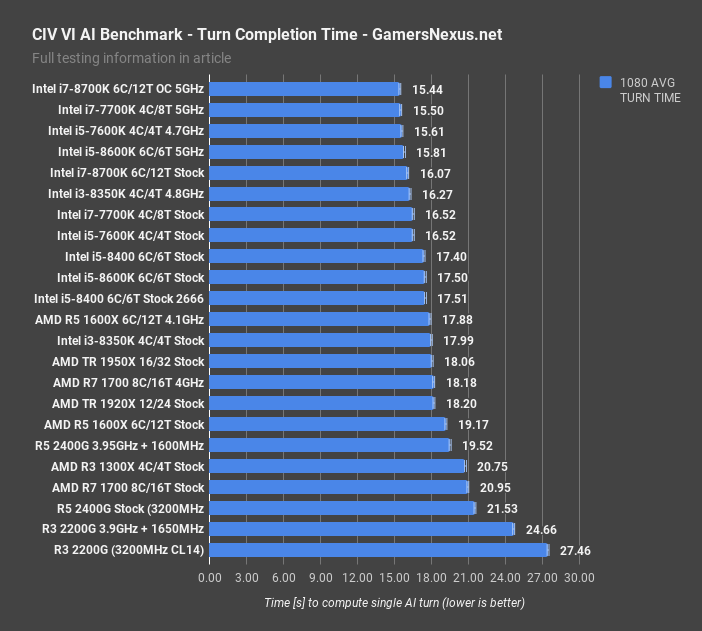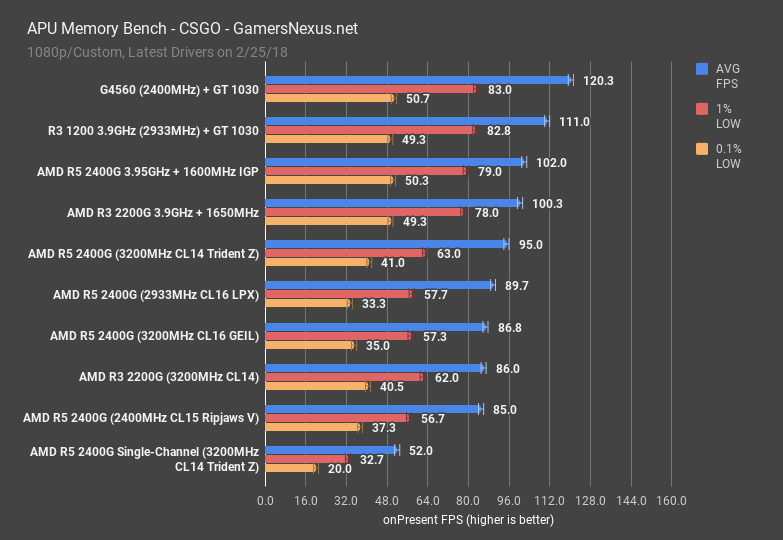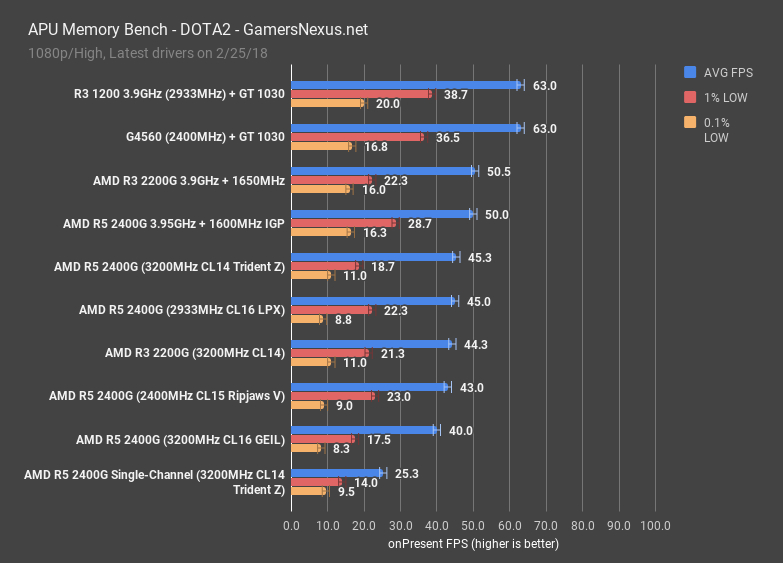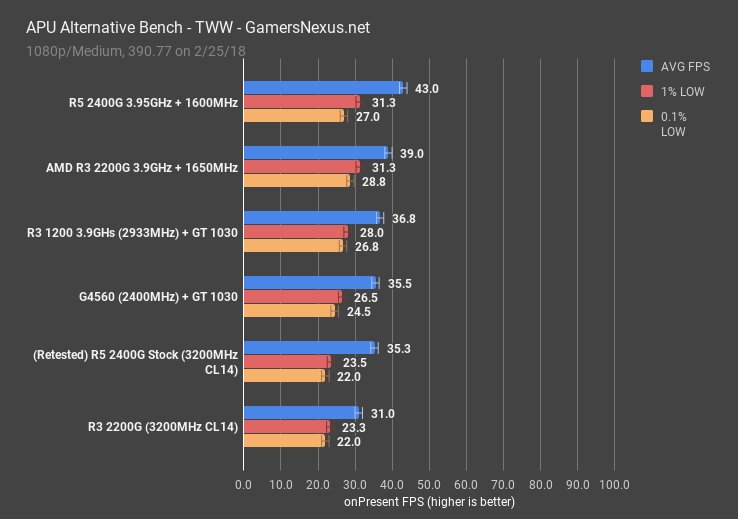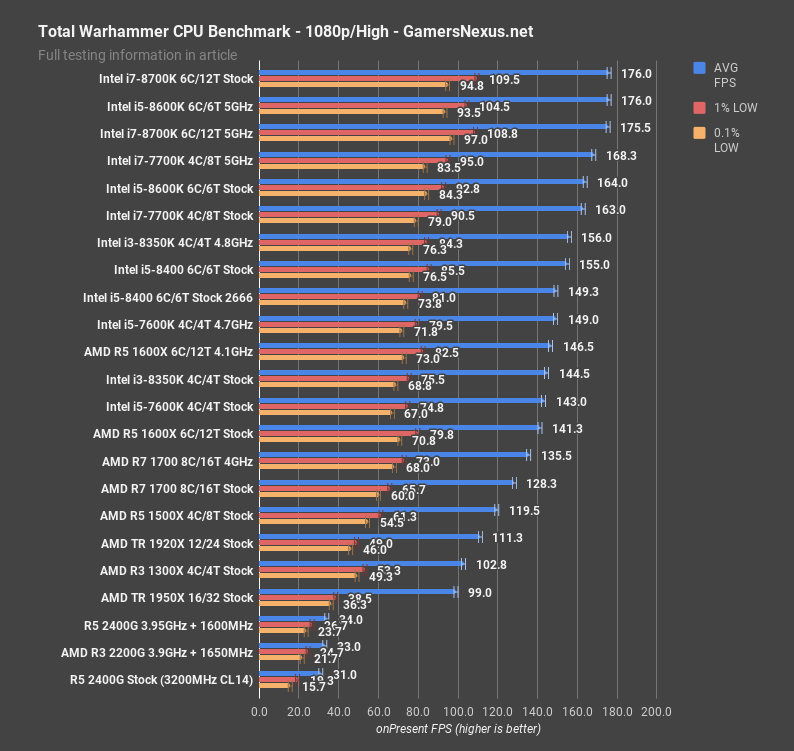Raven Ridge APUs are interesting as products. In a world where MSRP acted as an infallible decree handed down by galactic overlords, the GT 1030 would cost $70, the RX 560 would cost $100, and the G4560 would always have been $60. In this world, however, the GT 1030 has now usurped both the GTX 1050 and RX 560 in price, landing at $110 to $120, and the G4560 has… actually fallen in price, down to $60 from an overpriced $80 previously.
Then the R3 2200G and R5 2400G entered the market, priced at $100 and $170, respectively. These APU launches are different from previous APU launches: Previously, AMD has pushed variants of the Bulldozer architecture with older generation GPU components; today, Ryzen and Vega significantly outperform AMD’s previous parts, and are both found in the APUs.
We’re benchmarking the Raven Ridge parts entirely for gaming right now. In our eyes, the Raven Ridge APUs – the R3 2200G and R5 2400G – are gaming parts, and so we’ll leave the production workloads to the higher-end Ryzen desktop parts. We are also focusing our performance testing on the R3 2200G, R5 2400G, and competing, similarly priced dGPU + discrete CPU options. This includes the G4560 + GT 1030 and R3 1200 + GT 1030. For determining performance scalability, we have a few charts from our GPU bench (run with an unconstrained GPU on an i7-7700K). These are obviously not meant to compare the APU performance to high-end desktop components, but rather to offer perspective of scale – it’s a look at how much performance an APU provides at its price.
Note also that we’ve not bothered to test the Intel IGP performance, as we already know its performance is, comparatively speaking, garbage. There’s no need to do in-depth testing on that; no one should reasonably be using an Intel IGP for gaming at any meaningful quality level. Because our performance floor cuts the IGPs, we are left with the APUs and immediately competing discrete components.
Note that we previously covered APUs in these other content pieces:
One note prior to starting with the performance outline: For overclocking performance, we were able to push the R3 and R5 APUs to 1650MHz and 1600MHz, respectively, without blowing-out SOC voltage. We also pushed roughly 3.9-3.95GHz on the core. Note, though, that BCLK was not as clean as we’d like. The Gigabyte Gaming K5 motherboard seemed to dither between ~96.5BCLK and ~101BCLK, trending closer to 98-99BCLK. This will affect performance, naturally, to varying degrees. The impact is easy to calculate: Assuming an average BCLK of 98.5, applicable to overclocks, we end up at 39.5 x 98.5 = 3890.75MHz, rather than 3950MHz. Not a huge loss, but it does mean that frequency is not perfectly stable. This seems to be a characteristic of the motherboard.
We previously published significant data on memory kit scaling with AMD Raven Ridge APUs. We will not republish the data in this article, but would recommend that you give it a read. This is important data.
We believe the R3 2200G will be the rockstar to closely follow, as the R5 2400G is against fiercer competition. There’s not much competition – if any – at the R3’s $100 price.
As for testing, all memory kit information is listed in-line in the charts. If you have questions about which memory kit was used, as that is most impactful to performance, the answers should be in-line. Here is the primary test bench:
GN CPU Test Bench (Sponsored by Corsair)
Part | Component | Price |
CPU | This is what we’re testing! | $100, $170 |
Motherboard | $130 | |
Power Supply | TBD | |
Memory | Corsair Vengeance LPX 2933MHz | Varies |
GPU | GTX 1080 Ti FTW3 | $800 |
Cooler | NZXT Kraken X62 | $150 |
Overwatch Benchmark – R3 2200G & R5 2400G vs. GT 1030
We’re starting on Overwatch at 1080p/Medium. As discussed in our previous Bench Theory: Test Duration content, we run 5-minute test passes for Overwatch as its dynamic nature introduces variance. You can learn more about our Overwatch testing methodology over in the Bench Theory content.
The GT 1030 results are close to margin of error of one another. There’s some overlap, and so we can call the GT 1030 with G4560 and 2400MHz RAM as appreciably equal in performance to the overclocked R3, 2933MHz memory, and GT 1030. The AMD R5 2400G, overclocked to 3.95GHz and 1600MHz on the IGP, performed respectably close to the discrete devices. The part lands at 60FPS AVG, with lows similarly scaled to its competition. The APU ends up within margin of error of the GT 1030 and 3.9GHz R3 1200, with the G4560 and GT 1030 running a couple percentage points ahead.
Stock, the R5 2400G with 3200MHz CL14 RAM performs at 54FPS AVG, resulting in its overclock granting a 12% jump over the stock APU. Stock, the R5 2400G doesn’t impress in this game, but its overclock changes the stack significantly. The R3 2200G operates at 50FPS stock, with the 2400G leading by about 7%. For a $70 price increase, that’s not a big jump in performance.
Our 2200G overclocked the IGP a bit higher than our 2400G, and ended up at 55.5FPS AVG. It seems that there is some inherent advantage to the 2400G over the 2200G for Overwatch, it’s just a question of whether it’s worth $70 for a few percent.
Rocket League Raven Ridge Benchmarks (R3 2200G, R5 2400G)
Rocket League has the discrete parts placing at the top of the chart, plotting within margin of error of one another. This is an instance where we’ve become bound by the GT 1030, not by their partnered CPUs, and illustrates why we eliminate bottlenecks in discrete component reviews. This is not one of those, though – integrated GPU testing requires a more value-driven method.
The R5 2400G lands at around 61FPS when overclocked, placing its average FPS within our error margins for the top two discrete results. These are functionally equivalent in average framerate. They are not equivalent in lows, however; we noticed that the APU underperformed in 0.1% low metrics, something we can show better with this frametime plot:
The harder stutters are rare, fortunately, but they do occasionally pop-up and get noticed. Overall, the R5 2400G is doing well to keep up with two dedicated processing components.
Back to the main chart, the R3 2200G stock APU places at about 54FPS AVG, led by the stock 2400G by about 7.5%. Once again, for a $70 difference, this gap doesn’t seem worth the jump. Even low-end frametime performance isn’t all that disparate between the two.
Overclocking the 2200G pushed it to 60FPS AVG, impressively within standard deviation of discrete component performance.
Again, the low-end frametime performance isn’t excellent, but for a $100 part, this is hands-down impressive. The 2200G, with a bit of work on overclocking, readily proves itself as a cost-effective, competitively performant selection for Rocket League. The R5 2400G proves to be poor value in the face of AMD’s own 2200G, and the GT 1030 and G4560 would cost approximately $170-$190, depending on prices. Right now, at time of filming, a G4560 can be had for $60 after a new price reduction, and a GT 1030 can be had for between $110 and $120. The GT 1030 should be $70, but that’s not going to happen anytime soon – if ever – thanks to recent shortages. Given pricing equivalence with the 2400G, and relative performance of the 2200G, we have to again remark about the impressive performance of the $100 APU.
Sniper Elite (Dx12) Benchmark – R3 2200G, R5 2400G, G4560/GT 1030
Let’s move on to Sniper Elite 4. This game is sort of a best-case for AMD hardware, whereas something like the Source games can be more of a worst-case. Sniper Elite’s asynchronous compute and proper Dx12 implementation are well-leveraged on the APU.
First, note that this is 1080p/High. The settings are aggressive for an APU, and you should drop to lower settings for actual gameplay. The point of using higher settings is that these are what we use for our GPU benchmarks, so we have some extra data we can show. Treat this like something of a synthetic test, though know that scaling is linear as settings are reduced. We just liked this for the dGPU data – note that those were tested on our 7700K platform, so you get an unrestrained look at lower-end GPU performance, then we use the GT 1030 and G4560 for more reasonable comparisons.
The R5 2400G experiences a 10% uplift when overclocked from baseline. The GT 1030 and G4560, using the slower memory, ends up with the stock R5 leading by a noteworthy 17%. The overclocked R5 leads the GT 1030 and G4560 by 29%. The 2400G does well in this game, and would clearly be the better option to the GT 1030 and G4560.
Civilization VI AI Benchmark – R3 2200G & R5 2400G
Our Civilization VI benchmarks use turn time as a metric for performance, rather than frames per second. This is for a few reasons, one of which is that FPS analysis during CIV is largely irrelevant, the other is that it can be invalid: The longer a processor takes to complete a turn, the higher its framerate; in other words, slower processors perform better in FPS, which is because they spend more time staring at unchanging screens to process turns.
Because this does not rely upon GPUs for testing, we can show all other CPUs we’ve tested lately. Any CPU with unspecified memory speeds is running 3200MHz. In our testing, we found the overclocked R5 2400G to perform roughly equivalently to the R5 1600X in turn time processing, landing at about 19-20 seconds per turn. For five players, it would take 1.6 minutes to complete a full round until your next turn. Stock, the 2400G completes its turns approximately 2 seconds slower than overclocked, granting the overclocked 2400G a 9% turn time reduction. The overclocked 2200G completes its turns in about 24.7 seconds, with the stock 2200G distant from the pack, down at 27.5 seconds. The stock 2400G does hold a meaningful time reduction of 22% over the stock 2200G, and the overclocked variants put the 2400G as 21% reduced. We haven’t yet run the G4560 in this bench, but the R3 1300X runs between the stock and overclocked R5 2400G CPUs.
CSGO R3 2200G & R5 2400G APU Benchmarks
CSGO was one of the more sensitive games to memory changes, as we discussed previously. We’re still using the Trident Z kit as our baseline, as it worked the best with the Gaming K5 and the APUs.
The R5 2400G stock CPU performs at 95FPS AVG, with lows reasonably in lock-step. The R3 2200G operates at 86FPS AVG, permitting the 2400G a lead of 10.5%. The discrete components land between 111 and 120FPS AVG, a substantial lead over the overclocked and similarly priced – between $0 and $20 different – R5 2400G. The R3 2200G is the real winner, here, providing 83% of maximum performance, as rated relatively versus the chart-topping combo, for $100. To achieve 83% of performance at 58% of the price, plus or minus the impact of $10, is damn impressive. Granted, this is after we overclocked the R3, but overclocking isn’t particularly hard on these CPUs. Ryzen Master makes it more accessible than before, despite a preference for BIOS overclocking. For this title specifically, we’d recommend either the 2200G or the discrete component combination; the R5 2400G has limited usefulness in its price bracket for this title.
DOTA2 APU Benchmarks – R3 2200G & R5 2400G
DOTA2 will likely mirror CSGO, given the same roots, but let’s take a look.
We’ve become GPU bound in DOTA 2, with the G4560 and overclocked R3 1200 both maintaining 63FPS AVG. Either would be a suitable choice for our settings. The R3 2200G with a 1650MHz overclock roughly ties the overclocked R5 2400G, both at 50-51FPS AVG. The 2400G does manage to maintain advantaged 1% low frametimes.
Stock, the 2400G holds a 45FPS AVG, with the stock 2200G not meaningfully different. It would seem that we are bound elsewhere in the stack.
Total War: Warhammer APU Benchmarks
Total Warhammer at 1080p/Medium positions the overclocked APUs in commanding positions, managing to take the top two slots with the IGP overclock. The R3 1200 and GT 1030 follow in third, with the R3 2200G outperforming this discrete combo by roughly 6%. The R5 leads the R3 by about 10%, thanks to the game’s actual utilization of the additional resources.
As for stock, the APUs run behind the discrete components. Our R5 2400G stock APU operated a 35FPS AVG, with overclocking the 2400G granting a significant 23% uplift.
Above are the 1080p/High results for TWW. Not exactly what we’d recommend for the APUs, but it gives an understanding for the performance scaling of higher-end CPUs when unrestrained by the GPU. This is primarily for academic purposes – i.e. determining the point of bottlenecking.
Conclusion
The R3 2200G offers highly competitive performance at its price and, ultimately, really has no immediate competition. At $100, the CPU offers 78-85% of the performance of the R5 2400G at 58% of the price. Not bad at all. We can strongly recommend the R3 2200G for a low-end, budget-oriented system build. These APUs are not like their forefathers. Performance is significant enough to offer 1080p and medium/high settings for most “eSports” titles, e.g. Rocket League, CSGO, DOTA2, and so forth. The GT 1030 and low-end CPU argument doesn’t work against the R3 2200G – price is 1.7x-2x and performance is reasonably better, but not enough so that users who simply can’t stretch budget should go without a system. The R3 2200G fills that need, and we think it does it exceptionally well. The only downside to the R3 2200G is that it does not provide much in the way for upgrade options. If you’ve got the idea of buying a GPU later, we would recommend either a 2400G or a higher-end starter CPU for more growing room.
The R3 2200G also provides enough relative performance of the R5 2400G that there’s no need to make the usual “if I just spend $X more, I can get Y.” In a budget class like this, where every dollar can be a percentage point increase in component cost, there’s no room for that. The R5 2400G then more reasonably competes with the G4560/R3 1200 and a GT 1030. In this regard, the argument becomes shakier: We’ve already established the R3 2200G as our absolute low-end, no-frills component. For the slightly higher-end option, the G4560+GT 1030 cost anywhere between $170 and $210 right now (sometimes this goes higher – it depends on GPU availability). The combo should cost ~$130, but they don’t, so we’ll consider the price range as $170 to $210. The R3 1200 option would clearly be a bit higher (+$30-$40), so let’s focus on the G4560 + GT 1030 for now.
Prices are volatile right now. We are going to offer multiple conclusions that are contingent on price.
At price equivalence: We generally would favor the G4560 + GT 1030 option (with minor savings on 2400MHz memory). With the discrete components at +$20 or higher, the 2400G starts looking significantly better. It is at this point that we would strongly consider the 2400G, but would need to check memory and other current price trends.
We’d like to see the 2400G at ~$150-$160. We find the R3 2200G to be placed more or less perfectly, and would strongly encourage its purchase in low-end applications where another ~$70 is simply not an option – and we appreciate that many users may be in such a scenario. For those users, the 2200G – particularly with an overclock, which is not difficult – can offer most of the performance of a 2400G, in general, and does excellently with “lower-end” games. By this, we mean for the “eSports” or similar titles.
And finally, note that we can only speak to the games we’ve tested.
That’s all for this one.
Editorial, Testing: Steve Burke
Video: Andrew Coleman
